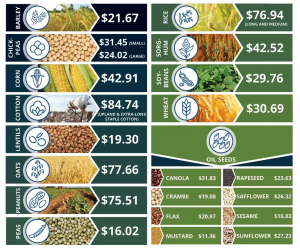Morning report: Corn, soybeans and wheat all trend lower ahead of Thursday’s session. (Comments are updated by 7:30 a.m. Central Time.)
NOTE: Market analyst Jacqueline Holland is on-site at the Farm Progress Show in Boone! Find her at the ADM Stage in the Wallaces Farmer Hospitality Tent at 10:00 a.m. CST daily for the LIVE Farm Futures Market Update.
Overnight trends:
Corn: Down 10 to 13 cents
Soybeans: Down 17 to 21 cents
Wheat: Down 3 to 9 cents
Grain prices were mixed in midweek trading yesterday, and they are back in the red ahead of Thursday’s open amid a late summer slump. Worries over U.S. production potential and Ukraine’s ongoing struggles have kept prices in overall great shape in recent months, but prices are also high enough to be prone to bouts of technical selling and profit-taking. (Bull markets need to feed on a regular basis to stay alive, in other words). Corn, soybeans and wheat all faced moderate declines of 0.5% to 1.0% overnight.
Overseas stock markets all tracked lower on Thursday. Asian markets closed with variable losses than ranged between 0.5% and 1.75%. European markets were all down around 1.5% in midday trading. On Wall St., the Dow dropped 194 points to 31,338 ahead of the opening bell as investors remain skittish about the Federal Reserve’s likely intent to keep aggressively raising interest rates in its battle against inflation.
Energy futures also eroded lower overnight. Crude oil dropped 2.25% lower to $87 per barrel on lingering demand concerns. Diesel tumbled 5% lower, while gasoline fell 3%. The U.S. Dollar firmed moderately.
The latest 72-hour precipitation map from NOAA shows bountiful rains for Texas (especially along the Gulf Coast), but the Midwest will be hard-pressed to find much measurable moisture between today and Sunday. Official 6-to-10-day forecasts show seasonally dry weather is likely for the northern third of the United States, while most of the country will see warmer-than-normal conditions between September 6 and September 10.
On Wednesday, commodity funds were net buyers of soyoil (+3,000) and CBOT wheat (+5,000) contracts but were net sellers of corn (-5,500), soybeans (-6,000) and soymeal (-5,500).
NOTE: We’ll report on trade estimates for the next round of export sales data, which would typically come out later today. However, there remains a bit of confusion on whether that will happen. USDA reported yesterday afternoon that it will revert to its “legacy system” while it works out technical issues that occurred when it attempted to port to a new system last week. The matter is expected to be fully resolved by September 15.
Corn
Corn prices appear to be caught up in a broad selloff that is affecting a wide set of stocks, energy and other commodities. Overnight losses amounted to around 1%. Traders are still closely monitoring weather forecasts, export trends and the ongoing Russian invasion of Ukraine.
Corn basis bids were mostly steady to weak on Wednesday, tracking 2 to 5 cents lower at three interior river terminals and tumbling 10 to 14 cents lower at two other Midwestern locations. An Ohio elevator bucked the overall trend after moving 8 cents higher.
Ethanol production shifted lower for the fourth-consecutive week, falling to a daily average of 970,000 barrels in the week through August 26, per the latest data from the U.S. Energy Information Administration. It was also the lowest weekly tally since late April. Stocks declined by 1% in the past week.
Ahead of the next USDA export report, analysts expect to see corn sales ranging between 15.7 million and 43.3 million bushels for the week ending August 25.
Hopefully, recent bouts of price volatility haven’t left you exhausted because more rounds are probably in store, according to Jim McCormick, hedging strategist with AgMarket.Net. “The tricky question at the moment is not necessarily the crop’s size, but the demand,” he notes. “On the domestic front, the Feed and Residual demand always seem to be a number which leaves traders scratching their heads and the USDA August balance sheet continued this trend.” McCormick offers additional analysis in the most recent Ag Marketing IQ blog – click here to learn more.
The preliminary report from the CBOT showed daily futures volume declined moderately to 237,982, with open interest firming by 4,308. Options volume dropped to 64,190 and now narrowly favors puts (32,764) over calls (31,426). Implied volatility for near-the-money December contracts eased to 29.8% and don’t expire for another 85 days.
Soybeans
Soybean prices incurred double-digit losses overnight in what is shaping up to be a broad selloff of stocks and commodities today. Prices slumped around 1.25% lower and will likely face an uphill battle in coming weeks as the 2022 season draws to a close without any major weather obstacles foreseeable in current forecasts.
Soybean basis bids were largely steady across the central U.S. yesterday but did climb 20 cents higher at an Indiana processor and fall 7 cents at an Ohio elevator.
Yesterday, private exporters announced to USDA the sale of 6.1 million bushels of soybeans for delivery to China during the 2022/23 marketing year, which begins September 1.
Prior to the next export report from USDA, analysts think the agency will show soybean sales ranging between 25.7 million and 66.1 million bushels for the week ending August 25. Analysts also expect to see soymeal sales ranging between 50,000 and 500,000 metric tons, plus up to 35,000 MT of soyoil sales.
How do your farm’s crop conditions stack up against other operations in the U.S.? Click this link to take the survey and share updates about your farm’s crop development. Farm Futures grain market analyst Jacqueline Holland regularly reviews and uploads results to the FFTF Google MyMap, so farmers can peer anecdotes from around the country.
When marketing grain, it’s probably wise to stay away from the extremes on either end. But what do those extremes look like, exactly? Ed Usset, marketing specialist at University of Minnesota, paints a picture in his latest Advanced Marketing Class blog – click here for details.
The preliminary report from CBOT showed daily futures volume down again, moving to 109,560, with open interest trending 3,293 higher. Options volume eased to 42,383 and more heavily favors puts (28,879) over calls (13,503). Implied volatility for near-the-money November contracts fell to 25.0% and expire in another 49 days.
Wheat
Wheat prices trended lower overnight, with some contracts down more than 1%. CBOT prices peaked in mid-May and fell sharply after that, stabilizing in mid-July. Prices have been mostly treading water since then, unable to find any meaningful momentum for much of the summer.
Ahead of the next export report from USDA, analysts expect the agency to show wheat sales ranging between 9.2 million and 23.9 million bushels for the week ending August 25.
The Ukrainian Agrarian Council estimates that the country’s 2023 wheat plantings could fall 30% to 40% due to a general lack of funds. That could leave a production of only 551.2 million bushels. Ukraine is typically one of the world’s largest wheat and corn exporters, but that status is obviously in jeopardy amid the ongoing Russian invasion, which has wreaked havoc on both Ukraine’s production potential as well as export logistics.
As expected, Japan has purchased 3.5 million bushels of food-quality wheat from the United States and Canada in a regular tender that closed earlier today. Of the total, 71% was sourced from the U.S. The grain is for arrival by the end of December.
South Korea purchased 2.3 million bushels of animal feed wheat, likely sourced from Australia, in a private deal that closed earlier today. The grain is for shipment between early January and early February.
Oman has received a shipment of 2.3 million bushels of wheat it purchased from Australia. The country’s information ministry says the grain will bring its strategic reserves to a six-month sufficiency.
The preliminary report from CBOT showed daily SRW volume at 78,224, with open interest trending 2,219 higher. Options volume moved to 15,712 and favors calls (9,136) over puts (6,576). Implied volatility for December near-the-money options eased to 39.1% and expires in 85 days.
Volume in HRW wheat fell to 26,539, with open interest trending 1,841 higher. Options volume is at 1,899 and heavily favors puts (1,527) over calls (372).
Get our top content delivered right to your inbox. Subscribe to our morning and afternoon newsletters!





